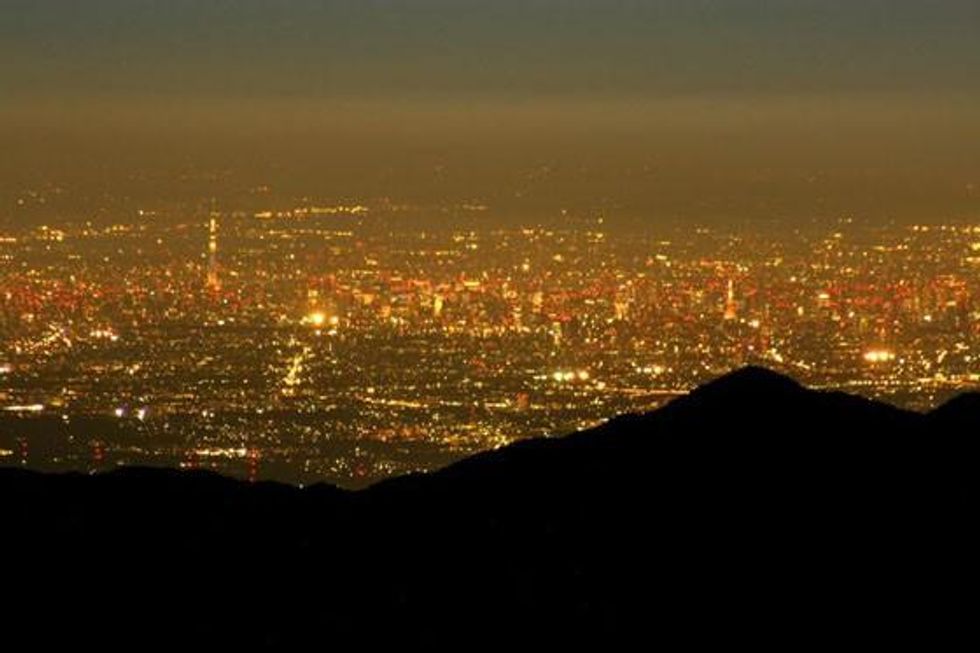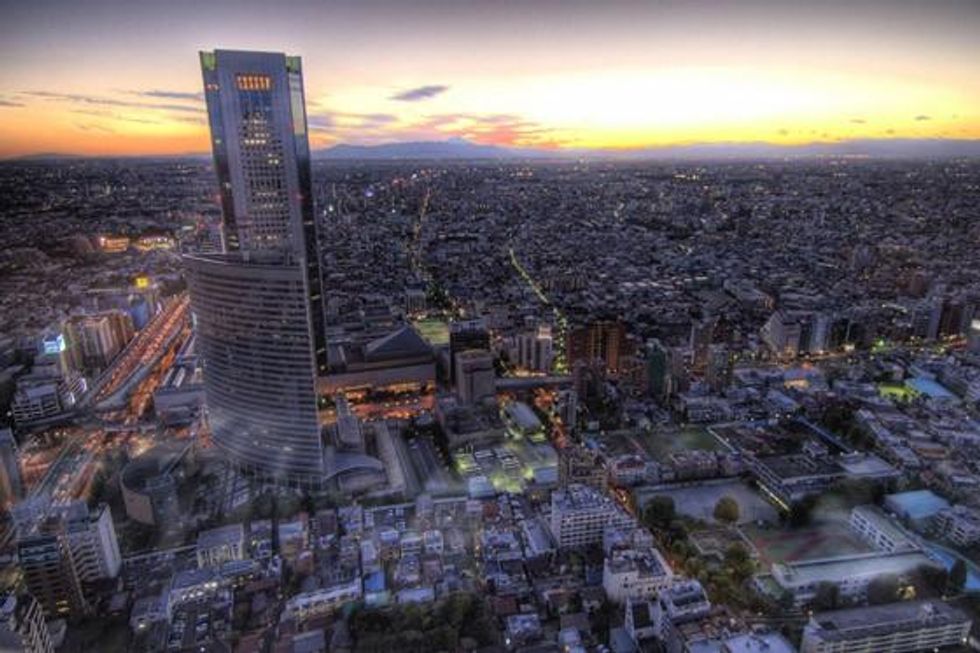

SUBSCRIBE TO OUR FREE NEWSLETTER
Daily news & progressive opinion—funded by the people, not the corporations—delivered straight to your inbox.
5
#000000
#FFFFFF
To donate by check, phone, or other method, see our More Ways to Give page.


Daily news & progressive opinion—funded by the people, not the corporations—delivered straight to your inbox.

Scientists say last year's Great East Japan Earthquake has greatly increased the pressure of the magma chamber underneath Mount Fuji. The pressure is now higher than it was the last time the volcano erupted more than 300 years ago, scientists say, according to a report Thursday.
Mount Fuji, in Shizuoka Prefecture, last erupted in 1707, less than two months after a large earthquake.
That blast scattered ash and cinders as far as Tokyo, 60 miles from the volcano.
Last year's earthquake and Fukushima nuclear crisis were unparalleled disasters, but people in and around Shizuoka Prefecture fear the ultimate catastrophe -- the eruption of Mount Fuji -- may be looming.
Experts at Japan's National Research Institute for Earth Science and Disaster Prevention say there is heightened pressure under Mount Fuji due to last year's devastating earthquake and aftershocks. It is feared the increase in pressure could trigger an eruption.
When Mount Fuji last erupted, the pressure caused by the prior earthquake was weaker than that of last year, the researchers said.
In May a team of researchers warned that the mountain may collapse if a newly-discovered fault-line underneath it shifts.
Based on the tectonic movements caused by the magnitude 9.0 quake that struck March 2011 and the magnitude 6.4 quake that followed four days later, the researchers estimate that about 1.6 megapascals of pressure were placed on the magma chamber, which is thought to be some 15 km underground. That's equivalent to an atmospheric pressure of some 15.8 kg per sq. cm.
In the past, 0.1 to several megapascals of pressure have been enough to trigger volcanic eruptions, including at Mount Fuji, it said. Although conditions in the magma chamber vary, 1.6 megapascals is "not a small figure," said Eisuke Fujita, a senior researcher at the institute.
A 2004 Japanese government report estimated that an eruption would cost the country over $30 billion US dollars. A new study is focusing on the potential damage that would be caused by a series of simultaneous earthquakes along the Nankai Trough, where it is feared another earthquake will soon take place. The most recent models have revealed that, in the worst-case scenario, 323,000 people would die and the tremors could trigger an eruption at Mount Fuji.
The huge quake of March 11, 2011 and tsunami that it generated devastated a large area of the country's northeast, killing around 19,000 people and generating the nuclear emergency at Fukushima.
* * *

* * *

# # #
Dear Common Dreams reader, The U.S. is on a fast track to authoritarianism like nothing I've ever seen. Meanwhile, corporate news outlets are utterly capitulating to Trump, twisting their coverage to avoid drawing his ire while lining up to stuff cash in his pockets. That's why I believe that Common Dreams is doing the best and most consequential reporting that we've ever done. Our small but mighty team is a progressive reporting powerhouse, covering the news every day that the corporate media never will. Our mission has always been simple: To inform. To inspire. And to ignite change for the common good. Now here's the key piece that I want all our readers to understand: None of this would be possible without your financial support. That's not just some fundraising cliche. It's the absolute and literal truth. We don't accept corporate advertising and never will. We don't have a paywall because we don't think people should be blocked from critical news based on their ability to pay. Everything we do is funded by the donations of readers like you. Will you donate now to help power the nonprofit, independent reporting of Common Dreams? Thank you for being a vital member of our community. Together, we can keep independent journalism alive when it’s needed most. - Craig Brown, Co-founder |

Scientists say last year's Great East Japan Earthquake has greatly increased the pressure of the magma chamber underneath Mount Fuji. The pressure is now higher than it was the last time the volcano erupted more than 300 years ago, scientists say, according to a report Thursday.
Mount Fuji, in Shizuoka Prefecture, last erupted in 1707, less than two months after a large earthquake.
That blast scattered ash and cinders as far as Tokyo, 60 miles from the volcano.
Last year's earthquake and Fukushima nuclear crisis were unparalleled disasters, but people in and around Shizuoka Prefecture fear the ultimate catastrophe -- the eruption of Mount Fuji -- may be looming.
Experts at Japan's National Research Institute for Earth Science and Disaster Prevention say there is heightened pressure under Mount Fuji due to last year's devastating earthquake and aftershocks. It is feared the increase in pressure could trigger an eruption.
When Mount Fuji last erupted, the pressure caused by the prior earthquake was weaker than that of last year, the researchers said.
In May a team of researchers warned that the mountain may collapse if a newly-discovered fault-line underneath it shifts.
Based on the tectonic movements caused by the magnitude 9.0 quake that struck March 2011 and the magnitude 6.4 quake that followed four days later, the researchers estimate that about 1.6 megapascals of pressure were placed on the magma chamber, which is thought to be some 15 km underground. That's equivalent to an atmospheric pressure of some 15.8 kg per sq. cm.
In the past, 0.1 to several megapascals of pressure have been enough to trigger volcanic eruptions, including at Mount Fuji, it said. Although conditions in the magma chamber vary, 1.6 megapascals is "not a small figure," said Eisuke Fujita, a senior researcher at the institute.
A 2004 Japanese government report estimated that an eruption would cost the country over $30 billion US dollars. A new study is focusing on the potential damage that would be caused by a series of simultaneous earthquakes along the Nankai Trough, where it is feared another earthquake will soon take place. The most recent models have revealed that, in the worst-case scenario, 323,000 people would die and the tremors could trigger an eruption at Mount Fuji.
The huge quake of March 11, 2011 and tsunami that it generated devastated a large area of the country's northeast, killing around 19,000 people and generating the nuclear emergency at Fukushima.
* * *

* * *

# # #

Scientists say last year's Great East Japan Earthquake has greatly increased the pressure of the magma chamber underneath Mount Fuji. The pressure is now higher than it was the last time the volcano erupted more than 300 years ago, scientists say, according to a report Thursday.
Mount Fuji, in Shizuoka Prefecture, last erupted in 1707, less than two months after a large earthquake.
That blast scattered ash and cinders as far as Tokyo, 60 miles from the volcano.
Last year's earthquake and Fukushima nuclear crisis were unparalleled disasters, but people in and around Shizuoka Prefecture fear the ultimate catastrophe -- the eruption of Mount Fuji -- may be looming.
Experts at Japan's National Research Institute for Earth Science and Disaster Prevention say there is heightened pressure under Mount Fuji due to last year's devastating earthquake and aftershocks. It is feared the increase in pressure could trigger an eruption.
When Mount Fuji last erupted, the pressure caused by the prior earthquake was weaker than that of last year, the researchers said.
In May a team of researchers warned that the mountain may collapse if a newly-discovered fault-line underneath it shifts.
Based on the tectonic movements caused by the magnitude 9.0 quake that struck March 2011 and the magnitude 6.4 quake that followed four days later, the researchers estimate that about 1.6 megapascals of pressure were placed on the magma chamber, which is thought to be some 15 km underground. That's equivalent to an atmospheric pressure of some 15.8 kg per sq. cm.
In the past, 0.1 to several megapascals of pressure have been enough to trigger volcanic eruptions, including at Mount Fuji, it said. Although conditions in the magma chamber vary, 1.6 megapascals is "not a small figure," said Eisuke Fujita, a senior researcher at the institute.
A 2004 Japanese government report estimated that an eruption would cost the country over $30 billion US dollars. A new study is focusing on the potential damage that would be caused by a series of simultaneous earthquakes along the Nankai Trough, where it is feared another earthquake will soon take place. The most recent models have revealed that, in the worst-case scenario, 323,000 people would die and the tremors could trigger an eruption at Mount Fuji.
The huge quake of March 11, 2011 and tsunami that it generated devastated a large area of the country's northeast, killing around 19,000 people and generating the nuclear emergency at Fukushima.
* * *

* * *

# # #